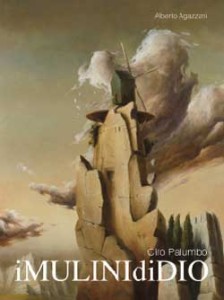 Ciro Palumbo – i MULINI di DIO – Convento di Santo Spirito – Nola
Ciro Palumbo – i MULINI di DIO – Convento di Santo Spirito – Nola
dal 18 ottobre al 2 novembre 2014
La mostra personale “i MULINI di DIO” di Ciro Palumbo, a cura di Alberto Agazzani, promossa dall’Assessorato ai Beni e alle Attività Culturali, s’inaugura nelle sale restaurate al piano terra del Convento di Santo Spirito ex Carceri di Nola.
L’itinerario espositivo si snoda attraverso 20 olii su tela e 8 olii su carta: le opere, tutte inedite, hanno come ispirazione l’opera di Pieter Brueghel il Vecchio nel famoso quadro Salita al Calvario del 1564 ben analizzato ed approfondito dal regista Lech Majewski nel film I colori della Passione.
Ciro Palumbo ricostruisce il viaggio dell’artista fiammingo partendo dalla metafisica presenza del Mulino e operando in un ideale parallelismo di atmosfere e riflessioni. Per l’artista cinquecentesco olandese tutto sembra terminare nel sacrificio del calvario, per Ciro Palumbo invece, quella fine è un nuovo inizio: è la vittoria del bene sul male, della luce sull’ombra, della speranza sugli inganni della solitudine.
Ciro Palumbo trasferisce sulla tela la profanazione del tempo che accoglie nel proprio inganno uomini, che nascono e muoiono, inevitabilmente girovaghi e prigionieri nella ragnatela dell’umano divenire; dipinge I Mulini di Dio che, per la stoltezza dell’umana indifferenza, precipitano rovinosamente, sopravvivono solo come macine ormai ridotte a semplici ruderi dentro scenografie sature dei colori del dramma.
Palumbo abbandona l’inserimento dell’elemento simbolico, riduce e distorce le prospettive dei luoghi e, con la potenza dei soli colori, evoca le suggestioni dolorose della profanazione dell’ombra e della solitudine. Il racconto si snoda per gruppi di opere che scandiscono le varie tappe del viaggio dove, alla fine, la farina della fede, grazie al lievito del sacrificio, diventa corpo mistico del pane.
 Il grande mulino al centro del dipinto fiammingo, e che simboleggia un Dio dominante ma pure, e di contro, la fatica di vivere, per Palumbo si trasforma in un’isola dei vivi, un nuovo ed inaspettato luogo dello spirito e della pittura, una nuova meta che impone un nuovo viaggio nell’invisibile. L’interesse di Palumbo al mistero panico del paesaggio, reso emblematico non a caso dal grande e solitario mulino, è il desiderio insaziabile di sondare il mistero infinito della pittura.
Il grande mulino al centro del dipinto fiammingo, e che simboleggia un Dio dominante ma pure, e di contro, la fatica di vivere, per Palumbo si trasforma in un’isola dei vivi, un nuovo ed inaspettato luogo dello spirito e della pittura, una nuova meta che impone un nuovo viaggio nell’invisibile. L’interesse di Palumbo al mistero panico del paesaggio, reso emblematico non a caso dal grande e solitario mulino, è il desiderio insaziabile di sondare il mistero infinito della pittura.
Ancora una volta Palumbo s’immerge nelle sue visioni, in quell’ossessione metafisica che lo porta ad intraprendere un viaggio per altre lidi ed altre isole, sfidando il tempo e lo spazio, la fisica e ogni realtà possibile.
La pittura qui riacquista e riafferma il suo straordinario primato di rappresentazione dell’invisibile, del trascendente, di un qualcosa per alcuni coincidente con Dio, per altri con una metafisica ancora tutta da dimostrare.
Catalogo in mostra, “i MULINI di DIO”, Edizioni Gagliardi
Info: Galleria Gagliardi Arte Contemporanea
Tel. 0577.942196 –
E-mail: galleria@galleriagagliardi.com
Associazione Pandora – Tel. 347.0755486
The solo exhibition “The Mills of God” by Ciro Palumbo, curated by Alberto Agazzani and promoted by the Council for Cultural Heritage, opens in the refurbished rooms on the ground floor of the Santo Spirito Monastery (formerly Nola Prison).
The exhibition comprises 20 oils on canvas and 8 oils on paper. The works, all of which are being shown for the first time, are inspired by the work of Pieter Brueghel the Elder in the famous painting The Procession to Calvary dated 1564, closely analysed and studied by the director Lech Majewski in the film The Mill and the Cross.
Ciro Palumbo reconstructs the journey of the Flemish artist, starting from the metaphysical presence of the Mill and working in an ideal parallelism of atmospheres and reflections. For the 16th century Dutch artist, everything seemed to end in the sacrifice at Calvary, while for Ciro Palumbo, that end is a new beginning: the victory of good over evil, of light over shade, of hope over the deceit of solitude.
Ciro Palumbo transfers to canvas the profanation of time which draws men into its deceit, men who are born and die, inevitably wanderers and prisoners in the spider’s web of human evolution; he paints The Mills of God which, due to the stupidity of human indifference, fall to the ground, surviving only as millstones, reduced to nothing more than ruins in settings steeped in the colours of drama.
Palumbo abandons the inclusion of the symbolic element, reducing and twisting the perspectives of the places, and, with the power of colours alone, evokes the painful suggestions of the profanation of shade and solitude. The story unfolds through groups of works which mark the various legs of the journey where, in the end, the flour of faith is transformed into the mystic body of bread thanks to the yeast of sacrifice.
The big mill in the centre of the Flemish painting, which symbolises a dominant God but also, on the contrary, the fatigue of living, is transformed by Palumbo into an island of the living, a new and unexpected place of the spirit and of painting, a new destination which imposes a new journey into the invisible.Palumbo’s interest in the Panic mystery of the landscape, made emblematic specifically by the large, lone mill, is the unquenchable desire to probe the infinite mystery of painting.
Once again, Palumbo immerses himself in his visions, in that metaphysical obsession which takes him on a journey to other shores and other islands, challenging time and space, physics and every possible reality.
Here, painting reacquires and confirms its extraordinary record for the portrayal of the invisible, of the transcendental, of a something which, for some people, coincides with God and, for others, with a metaphysical element which has still to be proven.
Catalogue in exhibition, “the MILLS of GOD”, Edizioni Gagliardi
Info: Galleria Gagliardi Arte Contemporanea
Tel. 0577.942196 –
E-mail: galleria@galleriagagliardi.com
Associazione Pandora – Tel. 347.0755486
www.galleriagagliardi.com





